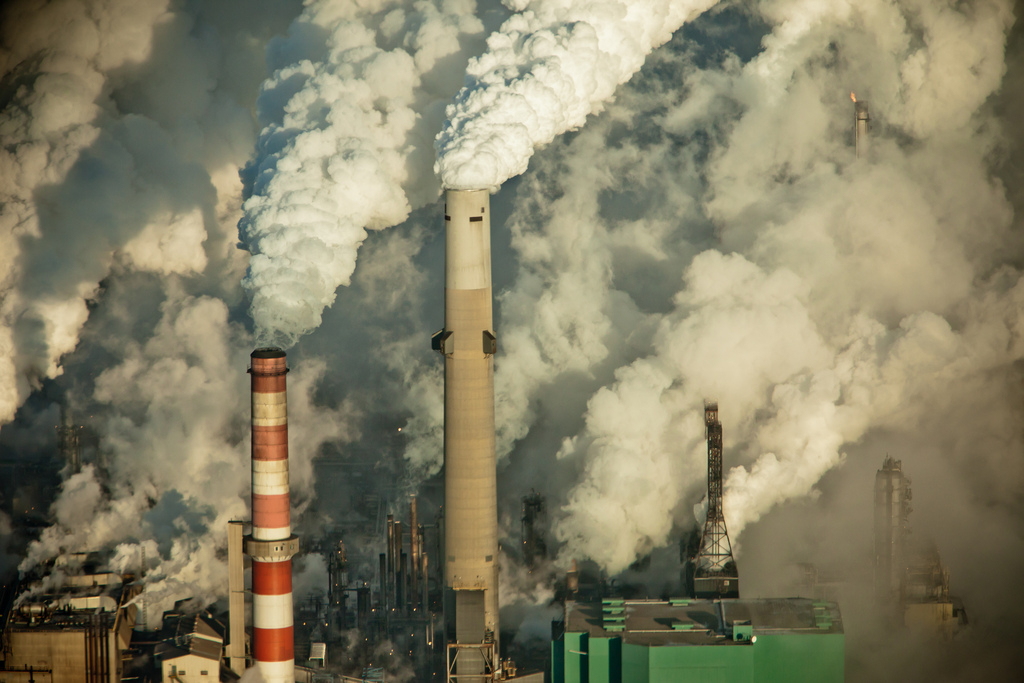Support strong Canadian climate journalism for 2025
Climate change is about fossil fuels. Most everyone gets that we need to burn way less coal, gas, and oil. But it can be more difficult to reckon with what this also means: we need to dig up way less of these fuels.
As many observers have pointed out, Canada will have a hard time meeting its climate goals at home if it keeps producing its main fossil fuel, oil. But there may be an even bigger story about oil and Canada: the global impact of oilsands growth could undermine international progress just as much.
In a new study, I tallied the global climate effect of expanding oilsands, finding a striking conclusion: oilsands expansion could counteract nearly all of Canada’s good intentions on reducing greenhouse gas emissions.
Here is how the oilsands expansion stacks up to everything else Canada is planning.
To start, it is important to know that Canada’s main climate goal is reduce its own oil and other fossil use substantially, cutting in-country greenhouse gas emissions 30% below 2005 levels (the starting year for the goals in Canada’s climate plan, called the Pan-Canadian Climate Framework). All progress is measured relative to that year, a time when Canada produced 0.9 billion barrels of oil.
But there is a contradiction: while Canada plans to reduce fossil fuel consumption, the National Energy Board expects production in the country’s oil industry to more than double over the same period, rising to 2.1 billion barrels of oil in 2030, from 0.9 billion barrels in 2005. (See Figure)

This contradiction is a problem for humanity, because adding more than a billion barrels to the global oil market has climate consequences that should be obvious. Each barrel of oil contains carbon that, once burned, releases at least 400 kilogrammes of carbon dioxide (CO2), the world’s most prevalent greenhouse gas.
Adding oil to the global market means more oil consumption and more emissions. That is straightforward, just simple supply and demand economics. Or, to spell it out, both oil users (think car buyers and factories) and oil producers (the oilsands and every other oil field) are sensitive to price. More oil supply means slightly cheaper oil means bigger cars and more driving and more oil used at factories. There are decades of evidence to support how much each of these producers and consumers respond to the cost of a barrel of oil.
It turns out that, in the long term, for each 1 billion barrels of oil added to the global market, global oil consumption increases between 0.2 billion and 0.6 billion barrels. And, just like that, Canada’s 1.2 billion barrels of added oil turns into more oil consumption, and 90 megatonnes to 280 megatonnes of new, incremental CO2 emissions around the world.
That is so much CO2 that it could overwhelm what Canada is trying to reduce in-country. Compare this 90 to 280 megatonne increase to the 175 megatonnes decrease Prime Minister Trudeau is hoping for from the Pan-Canadian Climate Framework by 2030. The problem is obvious: Canada is undermining, even perhaps entirely counteracting, its own climate plan by allowing oilsands production to expand.
These simple economics also show the fallacy of the line that if Canada fails to produce oil, someone else will, one-for-one. That may offer a convenient alibi for leaders, like Justin Trudeau, who both recognize that the climate crisis is caused by burning fossil fuels and also want to sell oil. But that is plainly wrong, as considerable research has shown that if more oil is available in the long term, more will be consumed in global markets.
Prime Minister Trudeau needs to reckon with this math. The world needs his climate leadership, as does Canada in its goal to increase its ambition under the Paris Agreement. If Canada – by flooding the future oil market – is undermining the desperate need for a safe climate for people anywhere, then what’s the point? There are other options for Canada’s economy, and Alberta’s, besides oil production.
Further, as a separate new study points out, Canada and most fossil fuel producers have a lot to lose by ignoring the connection between fossil fuel production and climate: the potential for severe economic disruption that could come by continuing to tie Alberta, and the country, to an industry where demand for its main product, oil, is being destroyed by technology innovation, including electric vehicles.
Instead, leaders of fossil fuel producing countries like Canada should solidify their economies by planning for a more predictable, stable path out of fossil fuel production, while simultaneously strengthening investment in other sectors, including low-carbon technology. Anything else, including completing the Kinder Morgan pipeline expansion, would further entangle Canada with the fossil fuel industry and runaway climate change.




Comments
So we're on track for either create climate catastrophe or the economic catastrophe described in yesterday's Tyee (https://thetyee.ca/Opinion/2018/06/13/Carbon-Bubble-Dirty-Thirties/?utm… ) .
The late unlamented Ralph Klein bragged about Alberta having no plan. He preferred to let "the market" have its way with us. Now we have a plan for tar sands expansion and it's every bit as bad as having no plan.
And we have a new premier in Ontario who wants to cut the price of gasoline which will only encourage people to buy bigger vehicles and drive more. The transportation sector is the largest contributor to Ontario's GHG emissions. In 2015, emissions from the transportation sector reached around 55 million tonnes of carbon dioxide equivalent (Mt CO2 eq). Passenger transportation emissions were at 35.3 Mt CO2 eq, while freight transport totalled 18.7 Mt CO2 eq.
The rise of emissions in passenger transportation is mostly due to people buying more fuel consuming vehicles, like pickup trucks, large SUVs and vans. Freight, on the other hand, is the fastest growing source of Ontario GHG emissions. Freight emissions in Ontario have doubled since 1990. They were 34% higher in 2015 compared to 1990.
Across Canada, emissions from the transportation sector have been increasing at an average annual rate of 1.1% since the 1990s. Canadian growing emissions in the transportation sector are also the result of consumers choosing to buy bigger vehicles, and the expansion of freight transportation.
Fossil fuel producers respond to consumers demand, and as long as we ask for the product they will provide it. Consumers respond to price; that's where government policies can make a difference. Reducing the price of gasoline and avoiding to put a price on carbon is surely not the way to go if we want to reduce our carbon emissions. Buying bigger gas-guzzling doesn't help either.
(source: National Energy Board, 2016-07-14. Market Snapshot: "Increased GHG emissions from the transportation sector reflect major consumer and business trends")